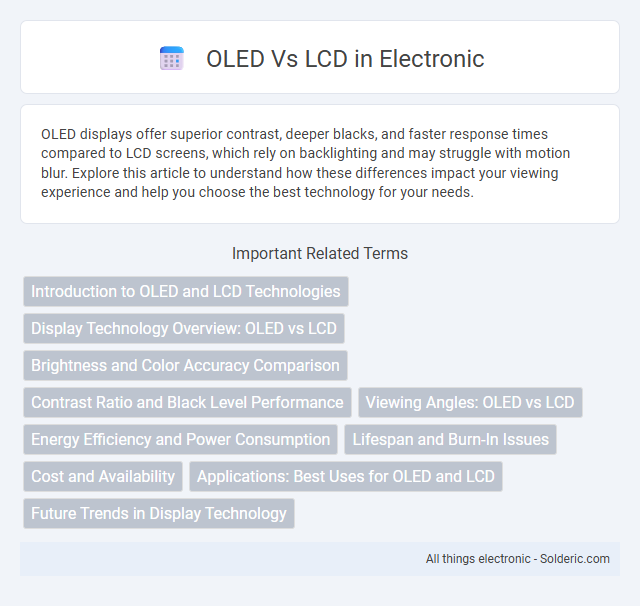OLED displays offer superior contrast, deeper blacks, and faster response times compared to LCD screens, which rely on backlighting and may struggle with motion blur. Explore this article to understand how these differences impact your viewing experience and help you choose the best technology for your needs.
Comparison Table
| Feature | OLED | LCD |
|---|---|---|
| Display Technology | Organic Light Emitting Diodes | Liquid Crystal Display with LED backlight |
| Contrast Ratio | Infinite (true blacks) | Typically 1000:1 |
| Color Accuracy | Superior, vibrant colors | Good, varies by panel type |
| Viewing Angles | Wide, minimal color shift | Narrower, color and contrast shift |
| Brightness | Moderate peak brightness | Higher peak brightness |
| Response Time | Fast, ideal for gaming | Slower than OLED |
| Power Consumption | Energy-efficient with darker images | Generally higher power use |
| Lifespan | Shorter, potential burn-in issues | Longer, no burn-in risk |
| Cost | Higher price point | More affordable |
Introduction to OLED and LCD Technologies
OLED (Organic Light Emitting Diode) technology uses organic compounds that emit light when an electric current passes through them, enabling thinner displays with higher contrast ratios and true black levels. LCD (Liquid Crystal Display) technology relies on a backlight shining through liquid crystals to produce images, offering energy efficiency and durability but often with limited contrast and color accuracy compared to OLED. Both technologies power modern screens, with OLED favored for superior image quality and LCD valued for cost-effectiveness and brightness in various lighting conditions.
Display Technology Overview: OLED vs LCD
OLED displays use organic compounds that emit light when electricity passes through, offering superior contrast ratios, deeper blacks, and faster response times compared to LCDs, which rely on a backlight to illuminate liquid crystals. LCD technology typically provides higher brightness levels and is often more affordable, making it common in a variety of devices. Understanding the differences in display technology helps you choose the right screen based on your preferences for color accuracy, viewing angles, and power efficiency.
Brightness and Color Accuracy Comparison
OLED displays offer superior color accuracy with deeper blacks and more vibrant hues due to their self-emissive pixels, while LCDs rely on backlighting that can limit contrast and color precision. LCD panels typically achieve higher brightness levels, making them more suitable for brightly lit environments, whereas OLED screens may struggle with peak brightness but excel in producing richer, more true-to-life colors. Your choice depends on prioritizing either the intense brightness of LCDs or the exceptional color fidelity and contrast provided by OLED technology.
Contrast Ratio and Black Level Performance
OLED displays offer superior contrast ratios and black level performance compared to LCD screens due to their ability to individually turn off pixels, producing true blacks and infinite contrast. In contrast, LCDs rely on backlighting, causing blacks to appear more like dark grays and limiting contrast capabilities. Your viewing experience benefits significantly from OLED's deep blacks and vivid contrast, especially in dark scenes and high-definition content.
Viewing Angles: OLED vs LCD
OLED displays deliver superior viewing angles compared to LCD screens due to their self-emissive pixel technology, which maintains color accuracy and contrast even at extreme angles. LCDs often suffer from color shifting and reduced brightness when viewed off-center because of their reliance on backlighting and liquid crystal alignment. When choosing a display for versatile viewing positions, your experience will benefit greatly from the consistent image quality offered by OLED panels.
Energy Efficiency and Power Consumption
OLED displays consume less power than LCDs when displaying darker images because each pixel emits its own light and can be turned off individually, resulting in significant energy savings. LCDs require a constant backlight regardless of image content, leading to higher power consumption, especially when displaying darker scenes. This inherent difference in light emission technology makes OLEDs more energy efficient in typical usage scenarios with varied brightness levels.
Lifespan and Burn-In Issues
OLED displays typically have a shorter lifespan compared to LCDs due to organic materials degrading over time, with an average lifespan of around 30,000 to 50,000 hours. Burn-in is a significant issue for OLED screens, where static images can cause permanent ghosting, whereas LCDs are much less susceptible to burn-in because they use a backlight instead of organic pixels. Despite OLED's superior contrast and color accuracy, users prioritizing longer durability and minimal burn-in risks often prefer LCD technology.
Cost and Availability
OLED displays generally have higher production costs due to their complex manufacturing process, resulting in higher prices compared to LCDs. LCD technology benefits from widespread availability and mass production, making it a more budget-friendly option for consumers. You can find a broader range of affordable LCD screens in various sizes and devices, while OLED panels tend to be limited to premium products.
Applications: Best Uses for OLED and LCD
OLED technology excels in applications requiring deep contrast and vibrant colors, such as high-end smartphones, premium televisions, and virtual reality displays, due to its ability to produce true blacks and wide viewing angles. LCD remains ideal for budget-friendly monitors, office displays, and large-screen TVs, offering reliable brightness, energy efficiency, and longevity at a lower cost. Medical imaging, outdoor signage, and industrial panels often favor LCD for its durability and superior visibility under bright ambient light.
Future Trends in Display Technology
Future trends in display technology emphasize the growing dominance of OLED panels due to their superior contrast ratios, flexibility, and energy efficiency compared to traditional LCD screens. Innovations in microLED technology promise even brighter displays with improved longevity, positioning them as strong competitors in the next generation of screens. Your viewing experience is set to benefit from these advancements through sharper images, deeper blacks, and more vibrant colors in a variety of devices.
OLED vs LCD Infographic

 solderic.com
solderic.com